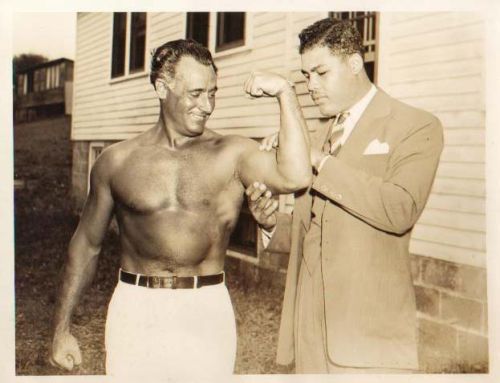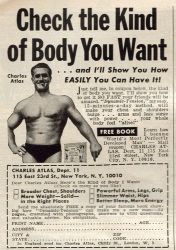Born in 1892, Charles Atlas is arguably one of the founding fathers of modern bodybuilding, probably motivating more skinny guys to jump into bodybuilding from the 1930s through the 70s than any other person. Even today, his iconic '97-pound weakling' advertisement is one of the most memorable ad campaigns of all time.
In the ads, a skinny guy and his girlfriend are lounging on the beach when a big buff muscle guy comes over to them and kicks sand in the little guy's face. The experience is so humiliating that after running across an ad for Charles Atlas' dynamic tension muscle-building program the 97-pound weakling is motivated to jump into bodybuilding. He buys the book and learns how to use Atlas' program to get big and buff. Next, he returns to the beach, beats the snot out of the bully and wins back his girl. Everyone is happy.
Charles Atlas said that in real life, he was a scrawny, 97-pound weakling who couldn't add muscle no matter how he tried. Today, he would be known as a hard-gainer—guys who just have a really tough time gaining mass. He tried different approaches but none of them worked.
He had a revelation though while watching a lion stretch at the zoo (some sources reference a tiger). He realized that lions were big and muscular even though they didn't lift weights. That's when he hit upon the idea of 'pitting muscle against muscle,' which spawned his dynamic tension approach to building muscle. He set about developing the program, first offering it to the public in 1922. Atlas' "Dynamic Tension" program was made up of 12 lessons and one final perpetual lesson. Millions of copies of the program have been sold over the past nearly 90 years—you can still buy it online today.
The Dynamic Tension program is essentially an approach to building strength and muscle solely using body weight. Its underlying premise is that it uses the power of one muscle group against another. Other than some normal household items—like a couple of chairs—you don't need any special equipment or weights. Dynamic Tension movements involve three exercise disciplines to varying degrees: isotonic; isokinetic and isometric.
The movements are performed by tensing the muscles of a body part and then moving that body part against the tension. The idea is to imagine that you are lifting a heavy weight—but you're not. All of the movements are performed in a slow, controlled manner with a strong emphasis on proper breathing.
Dynamic Tension movements are often used by guys who participate in martial arts. The movements are ideal for them because it involves both tightening of the core muscles, changes in movement tempo and controlled breathing. Performing these movements helps them to develop power, speed and control.
One of the main benefits of Dynamic Tension exercises are that they can be performed anywhere. This makes them ideal for someone who is traveling or has limited time to train. Since the exercises don't require a lot of space, they can be performed in a hotel, a bedroom or just about anywhere. Another big benefit of this type of exercise is that because no weights or equipment is involved, the risk of injury is low. Dynamic Tension would also be a good choice for someone who is recovering from an injury and is looking to 'ease back into' training again.
As an ongoing, regular training routine, Dynamic Tension has limited appeal. While yes, it can build strength and improve flexibility, you're never going to get huge doing just body weight exercises. If you are skinny and just starting out, Dynamic Tension can help you add muscle but only to a degree because after a while you'll hit a plateau. If you want to get big, you're going to need to add weights.
That's not to say that the program isn't without merit for the bodybuilder. It's just not something you want to make a mainstay of your routine. It's great if you're recovering from an injury, traveling or just to improve your flexibility or breathing control. And if you take the time to actually follow Atlas' program as he intended, you could also benefit from the mental discipline that is incorporated into each of the steps.
There's no denying that the name Charles Atlas ranks among the most legendary names in bodybuilding. However, because Atlas' program didn't involve the use of weights his greatest sphere of influence stems from the fact that he helped popularize the sport of bodybuilding by inspiring generations of young men to get fit. He even influenced bodybuilding greats such as Arnold Schwarzenegger and Jake "Body by Jake" Steinfeld.
More Information About Muscle Building Click Here
Source 4 Foods Never To Eat
Source 4 Foods Never To Eat


No comments:
Post a Comment